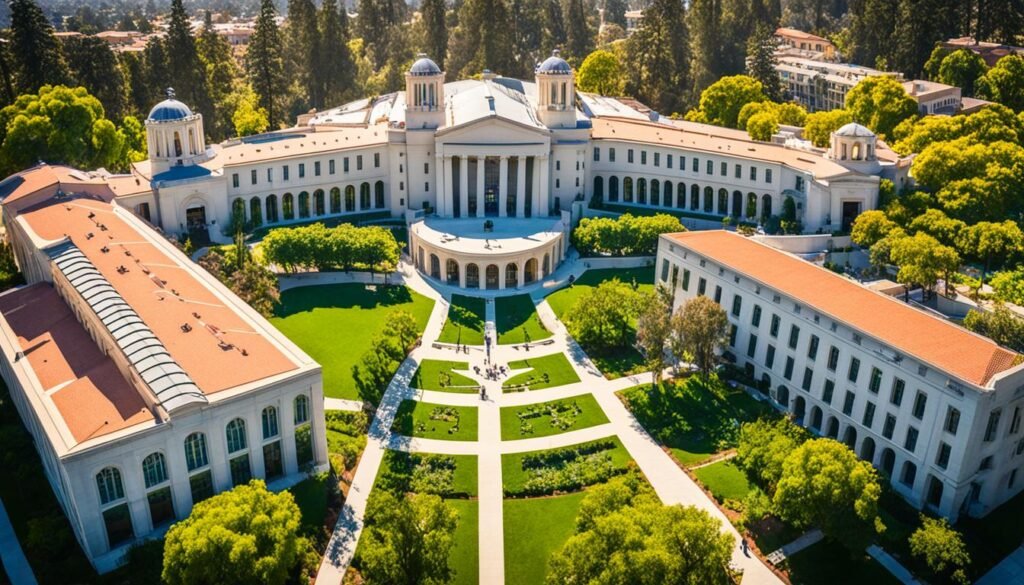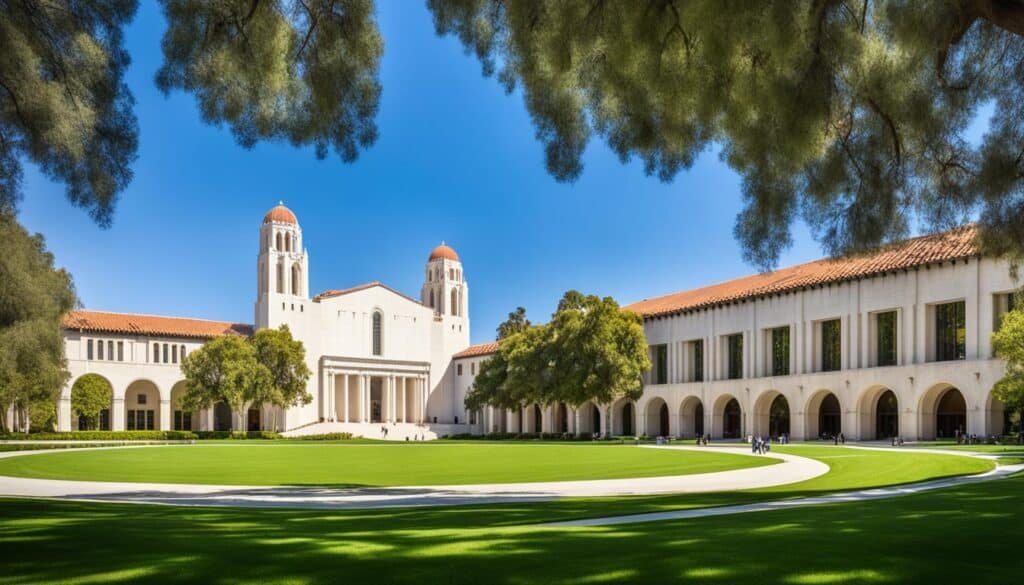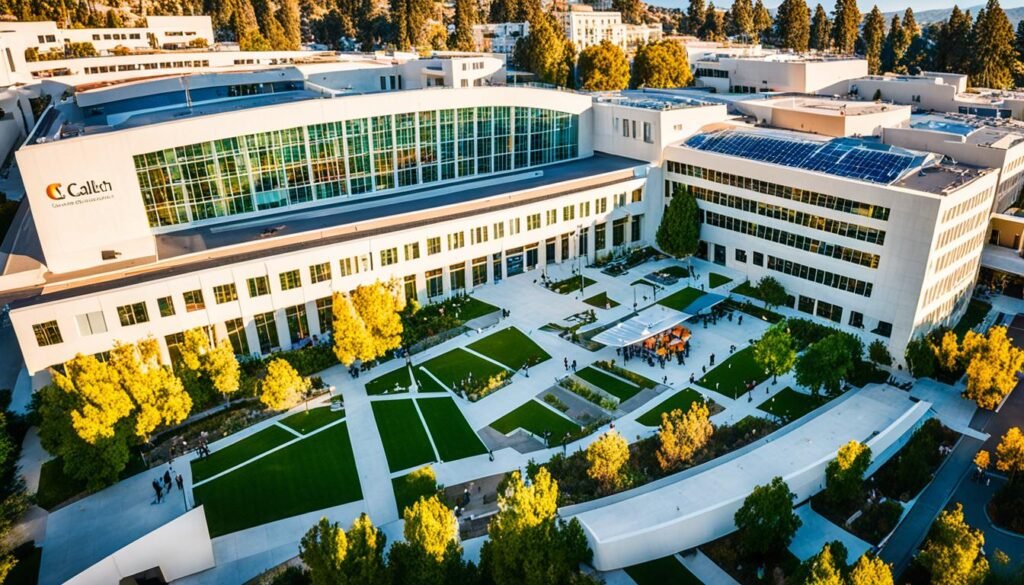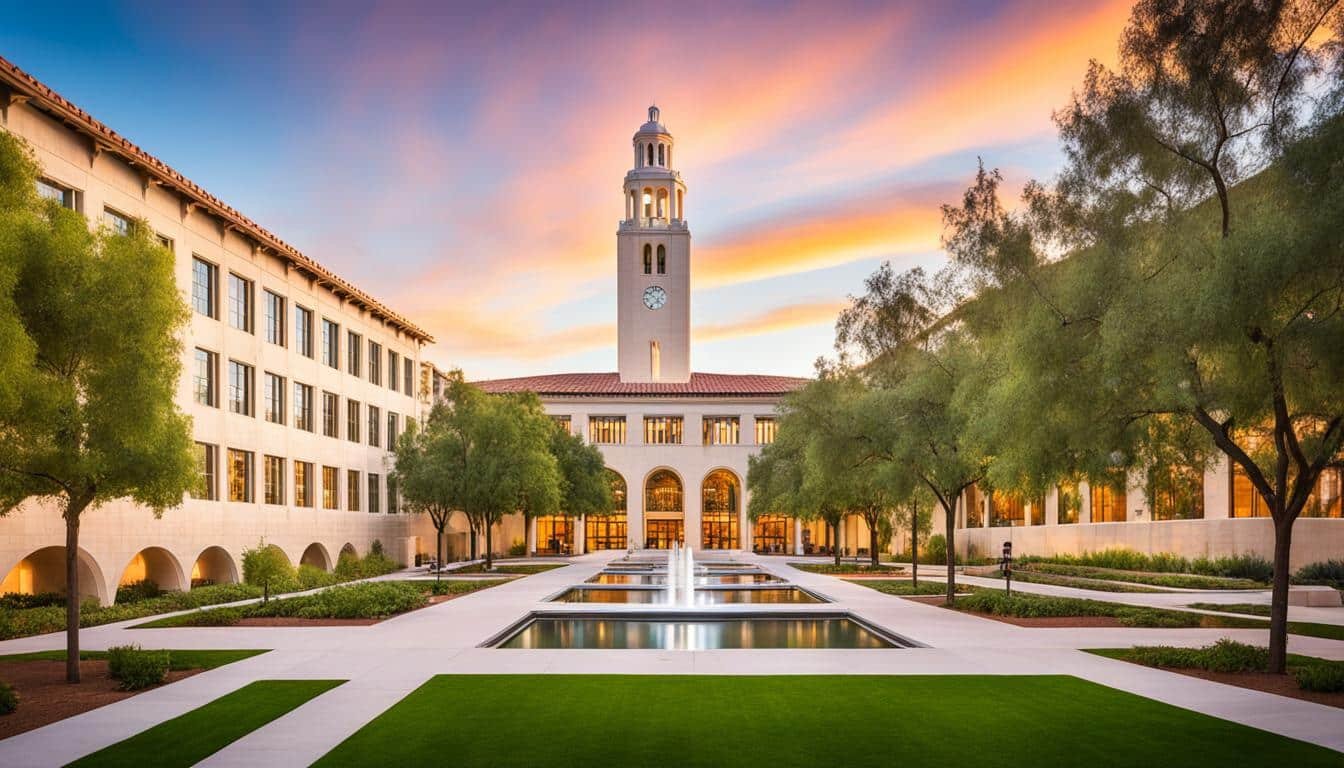The California Institute of Technology (Caltech) is a top private research university in Pasadena, California. It started in 1891 as a vocational and preparatory school by Amos G. Throop. Now, it’s a leading place for science and engineering.
Caltech is famous for its groundbreaking research and tough academic programs. It’s known for big discoveries in physics, chemistry, biology, and aerospace engineering. With about 2,400 students, it offers a special learning experience.
Students get to do hands-on research and enjoy a lively campus life. Caltech is highly ranked by top organizations like the QS World University Rankings and U.S. News & World Report.
Key Takeaways
- Caltech is a world-renowned private research university located in Pasadena, California.
- The university was founded in 1891 and has since become one of the most prestigious science and engineering institutions in the world.
- Caltech is known for its cutting-edge research, rigorous academic programs, and innovative breakthroughs in fields like physics, chemistry, biology, and aerospace engineering.
- With a small student body and a highly selective admissions process, Caltech offers a unique educational experience.
- The university is consistently ranked among the top universities in the world by prestigious organizations like the QS World University Rankings and U.S. News & World Report.
About California Institute of Technology
Caltech, also known as the California Institute of Technology, is a top university 11 miles northeast of Los Angeles. It started in 1891 as Throop University, a small school. Over time, it grew into one of the top science and engineering schools in the world.
Background and History
Caltech has changed names several times, like Throop Polytechnic Institute and Throop College of Technology, before becoming Caltech in 1920. Famous scientists and engineers like George Ellery Hale and Robert Andrews Millikan helped shape its focus on science and engineering.
Mission and Vision
Caltech aims to push the boundaries of knowledge and train future leaders. It offers tough academic programs and top research facilities. The university wants to keep making big discoveries and innovations that change society for the better.
| Fact | Description |
|---|---|
| Founding | Caltech was founded in 1891 as Throop University, a small vocational and preparatory school. |
| Name Changes | Over the decades, the institution underwent several name changes, including Throop Polytechnic Institute and Throop College of Technology, before officially becoming the California Institute of Technology in 1920. |
| Notable Faculty | Caltech has attracted some of the world’s most renowned scientists and engineers, such as George Ellery Hale, Arthur Amos Noyes, and Robert Andrews Millikan. |
| Mission | Caltech’s mission is to advance the frontiers of knowledge and to train the next generation of scientific and technological leaders. |
| Vision | Caltech’s vision is to continue its legacy of groundbreaking discoveries and innovations that have a profound impact on society. |
“Caltech’s mission is to advance the frontiers of knowledge and to train the next generation of scientific and technological leaders.”
Academic Excellence at Caltech
The California Institute of Technology, or Caltech, is famous for its top-notch academic programs and tough curriculum. It’s a small group of institutes in Pasadena, northeast of downtown Los Angeles. Caltech is a leader in research and excels in areas like humanities and social sciences, chemistry and chemical engineering, and more.
Undergraduate Programs
Caltech’s undergrad program is all about hands-on research and working with top professors. Students get to work on cutting-edge projects and help out at places like the caltech seismological laboratory. With small class sizes and a focus on each student, Caltech offers a unique learning experience.
Graduate Programs
Caltech’s graduate programs are top-tier, offering master’s and doctoral degrees. It draws the best students globally for advanced studies and research. Caltech’s graduate programs are highly ranked, showing its dedication to known for his work and innovation in education and research.
| Academic Division | Undergraduate Programs | Graduate Programs |
|---|---|---|
| Engineering and Applied Science | Aerospace Engineering, Mechanical Engineering, Electrical Engineering | Aerospace, Mechanical, Electrical Engineering, Computer Science |
| Humanities and Social Sciences | Economics, History, Philosophy | Economics, History, Political Science |
| Biology and Biological Engineering | Biology, Bioengineering | Biology, Bioengineering, Neuroscience |
| Chemistry and Chemical Engineering | Chemistry, Chemical Engineering | Chemistry, Chemical Engineering |
| Physics, Mathematics and Astronomy | Physics, Mathematics, Astrophysics | Physics, Mathematics, Astronomy |
| Geological and Planetary Sciences | Geology, Geophysics, Planetary Science | Geology, Geophysics, Planetary Science |
Caltech’s programs are among the best in the country and the world. Its small group of institutes and faculty of caltech give students amazing chances to work on groundbreaking projects. This helps advance knowledge in their fields.
Cutting-Edge Research at Caltech

The California Institute of Technology, also known as Caltech, is famous for its leading research in many scientific and engineering fields. This top research university is just 11 miles northeast of Los Angeles. It has world-class research centers and facilities. These help its faculty and students explore new areas of knowledge.
Research Centers and Facilities
Caltech’s main research spot is the Seismological Laboratory. It’s a top place for studying earthquakes. The university also runs the Jet Propulsion Laboratory (JPL) for NASA. This work helps space exploration and brings new ideas in science and engineering.
Caltech is all about the latest research. It has top facilities like the Cahill Center for Astronomy and Astrophysics, the Keck Center for Nanoscale Science and Technology, and the Broad Center for the Biological Sciences. These places let Caltech’s gifted students and famous teachers work on big challenges. They focus on areas like quantum physics, sustainability science, and space exploration.
“Caltech’s research endeavors are further supported by state-of-the-art laboratories, enabling faculty and students to push the boundaries of scientific knowledge.”
Caltech is a top science and engineering school thanks to its strong research setup and teamwork. It’s a key innovation hub in the U.S. and worldwide.
California Institute of Technology Rankings and Achievements

The California Institute of Technology, known as Caltech, is a top-ranked university. It’s famous for its excellence in research and education. Caltech leads in science, engineering, and technology.
Caltech is highly ranked worldwide, often in the top 10. This shows its dedication to top-notch education and research. It covers many areas, like the humanities and social sciences, and chemistry.
Caltech’s team and alumni have won many top awards. They’ve earned 79 Nobel Prizes, 4 Fields Medals, and 6 Turing Awards. These awards highlight Caltech’s talent and its big impact on knowledge.
Caltech has made big discoveries, like finding the electron. Its researchers have made huge strides in space and quantum computing. Their work keeps pushing the limits of what we can do.
Caltech is 11 miles northeast of downtown Los Angeles. It’s a place where bright minds come together. The campus has beautiful buildings and gardens, near the Pasadena Playhouse District.
Admissions and Financial Aid
Getting into the California Institute of Technology, or Caltech, is tough. Every year, thousands of top students from all over the world apply. But only a few get in. Caltech looks at your grades, test scores, activities, and essays when deciding.
Caltech wants the best students, no matter their money situation. It offers scholarships, grants, and work-study programs. Over 50% of undergrads get some kind of financial help, making top education available to more students.
Competitive Admissions Process
Caltech gets lots of applications every year for a limited number of spots. Students who get in are usually at the top of their class. They have great grades and love science, technology, engineering, and math (STEM).
Scholarships and Aid Opportunities
- Caltech has scholarships and grants for talented students, like the Summer Undergraduate Research Fellowships and the National Medal of Science and Nobel Prize in Physiology or Medicine awards.
- Over 50% of undergrads get financial help, making Caltech’s top education open to more students.
- Caltech’s aid packages help students focus on their studies without worrying about money, supporting the most talented students.
Caltech works hard to bring in the brightest minds and support them. It shows Caltech’s strong focus on excellence in education, space, and engineering.
Campus Life at Caltech

At Caltech, life is more than just classes. It’s a vibrant, engaging community. As a top private research university, Caltech offers students a world-class education. They also get a dynamic campus experience.
Housing and Dining
All first-year students must live on campus. Caltech guarantees housing for all undergrads. This creates a supportive living environment where students build strong bonds.
Caltech has many dining options. They cater to different diets and tastes.
Student Organizations and Activities
Caltech students have many clubs and activities outside class. There are sports teams, arts groups, and community service clubs. This lets students explore their interests and develop leadership skills.
Students can join in the Caltech Carnival or various clubs. There’s something for everyone at this lively campus.
The Caltech campus is a mix of academic excellence, cutting-edge research, and a thriving student community. It offers an unmatched experience for those who want to advance science and technology.
Notable Alumni and Faculty

Caltech has a long history of producing top scholars, scientists, and innovators. Its alumni and faculty have won many awards, like 79 Nobel Prizes, 4 Fields Medals, and 6 Turing Awards.
Notable alumni include physicist Richard Feynman, chemist Linus Pauling, computer scientist Alan Kay, and Nobel Laureate in Physics Kip Thorne. These people have made big changes in their fields. They’ve helped shape science, technology, and society.
Caltech’s faculty have also made a big impact. Famous names like theoretical physicist Richard Feynman, astronomer George Ellery Hale, and biologist Thomas Hunt Morgan worked here. They’ve expanded our knowledge and innovation.
Caltech’s students and teachers lead in making new discoveries and tech advances. This has made Caltech a top research place. Their work has greatly influenced science, engineering, and more.
| Caltech Alumni | Caltech Faculty |
|---|---|
| Richard Feynman (Nobel Laureate in Physics) | Richard Feynman (Nobel Laureate in Physics) |
| Linus Pauling (Nobel Laureate in Chemistry) | George Ellery Hale (Nobel Laureate in Astronomy) |
| Alan Kay (Turing Award winner) | Thomas Hunt Morgan (Nobel Laureate in Biology) |
| Kip Thorne (Nobel Laureate in Physics) | Linus Pauling (Nobel Laureate in Chemistry) |
Caltech’s alumni and faculty show the school’s dedication to excellence. Their work has a lasting effect on science and technology.
Caltech’s Impact on Science and Technology

The California Institute of Technology, or Caltech, has made a big impact on science and technology. It’s a small group of institutes known for top-notch research. Caltech has made many groundbreaking discoveries and innovative solutions.
Groundbreaking Discoveries
Caltech’s researchers have changed fields like quantum physics, earthquake monitoring, protein engineering, and sustainable energy. They found the electron and made the first solar cell that works from sunlight.
Caltech’s biggest achievement is finding gravitational waves with LIGO. This discovery, which won the 2017 Nobel Prize in Physics, has changed how we see the universe.
Innovations and Spinoffs
Caltech has also started many tech companies and startups. These companies use Caltech’s top research and talent to solve real-world problems. From chemistry to social sciences, Caltech’s impact is huge.
Caltech keeps pushing the limits of what we know. Founded in 1891 as a preparatory and vocational school, it’s now a top small group of institutes in the U.S., near Los Angeles.
“Caltech is a place where you can come and really change the world. The level of research and innovation here is truly remarkable.”
– A Caltech faculty member
Partnerships and Collaborations

Caltech’s reach goes far beyond its campus, thanks to its many partnerships worldwide. It works closely with top institutions globally. A key partnership is with NASA, where Caltech runs the Jet Propulsion Laboratory (JPL) for NASA.
NASA and JPL Collaboration
JPL has been crucial for NASA’s big space missions, like the Voyager probes and the Mars Curiosity rover. Caltech also connects with groups like the Association of American Universities (AAU) and the Association of Pacific Rim Universities (APRU). These connections help Caltech lead in research and global projects.
These partnerships help Caltech advance science and engineering. They make big strides in knowledge and help humanity. By working with top institutions worldwide, Caltech tackles big challenges and innovates globally.
“Caltech’s partnerships and collaborations have been instrumental in driving scientific and technological progress, expanding the frontiers of human knowledge, and making a meaningful impact on the world.”
Also Read : Explore Academics At Vincennes University
Location and Visiting Caltech
Caltech’s campus is in Pasadena, California, about 11 miles northeast of Los Angeles. It’s near Pasadena’s historic Old Town and the lively Pasadena Playhouse District. These places are often visited by Caltech’s faculty and students.
Exploring Pasadena
Caltech is a top science and engineering school in the U.S., right in Pasadena. This city is famous for its research centers and STEM colleges. Students at Caltech get to live on campus, but they can also enjoy Pasadena’s culture, fun activities, and food.
Pasadena is where some of the brightest students and innovators come to study at Caltech. They’re attracted by Caltech’s tough entry process and its fame as a leading STEM college. Caltech, known to many as “Caltech,” has a rich history since 1891. It’s a place for groundbreaking research, summer research programs, and the work of Nobel winners and National Medal of Science winners.
FAQs
Q: What is the California Institute of Technology known for in 2024?
A: In 2024, the California Institute of Technology, commonly known as Caltech, is renowned for its high research output and commitment to scientific research, particularly in the fields of science and engineering. It is frequently ranked among the top universities in the world.
Q: How does Caltech’s student life differ from other universities?
A: Caltech’s student life is unique due to its small size and focus on scientific research. With approximately 11 undergraduate students per faculty member, students have ample opportunity to participate in research and engage closely with faculty. The vibrant campus culture also includes various extracurricular activities and traditions.
Q: What are the latest world university rankings for Caltech?
A: According to the US News Best Global Universities rankings, Caltech consistently ranks among the top institutions worldwide, often competing closely with the Massachusetts Institute of Technology.
Q: Does Caltech offer graduate degree programs?
A: Yes, Caltech offers graduate degree programs across its six academic divisions, allowing graduate students to immerse themselves in advanced research and specialized fields of study.
Q: How does Caltech’s research institute contribute to scientific advancements?
A: Caltech’s research institute is a hub for scientific advancements, focusing on innovative projects that often lead to breakthroughs in various disciplines. The institute encourages students to participate in research that fuels discoveries, including those that harness fuels directly from sunlight.
Q: What athletic programs does Caltech participate in?
A: Caltech competes in the NCAA Division III and is a member of the Southern California Intercollegiate Athletic Conference. The Caltech Beavers represent the university in various sports and engage in athletic competitions.
Q: Where is Caltech located, and what is its proximity to local attractions?
A: Caltech is located in Pasadena, California, within walking distance of Old Town Pasadena and the Pasadena Playhouse, providing students with access to cultural and entertainment opportunities.
Q: What is the history of Caltech’s founding?
A: Caltech was founded as a preparatory school in the late 19th century and has since evolved into a leading research institute in Southern California, recognized for its contributions to technology and science.
Q: What role does Caltech play in the field of social sciences?
A: Although Caltech is primarily known for its emphasis on science and engineering, it also offers programs in social sciences, encouraging interdisciplinary research and exploration of societal impacts related to technological advancements.
Source Links
- https://www.caltech.edu/campus-life-events/calendar/discover-caltech-discotech-1
- https://www.caltech.edu/campus-life-events/calendar/discover-caltech-discotech-2023-1
- https://en.wikipedia.org/wiki/California_Institute_of_Technology





